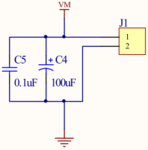bobsun
Full Member level 2
Hello,
I would like to ask a question on capacitor.

I have found that frequently when a “big” capacitor is connected to the ground, it is often accompanied by a “small” capacitor in parallel with it. For example, in the attached image, C4 is 100µF and C5, which is connected in parallel, is only 0.1 µF.
In terms of charge storage, there is only 1/1000 of C4 that C% could store at the same voltage level; then why is it put here? I have seen such arrangement quite common: in motor design, boost circuit and elsewhere. What is the principle here?
Bob
I would like to ask a question on capacitor.

I have found that frequently when a “big” capacitor is connected to the ground, it is often accompanied by a “small” capacitor in parallel with it. For example, in the attached image, C4 is 100µF and C5, which is connected in parallel, is only 0.1 µF.
In terms of charge storage, there is only 1/1000 of C4 that C% could store at the same voltage level; then why is it put here? I have seen such arrangement quite common: in motor design, boost circuit and elsewhere. What is the principle here?
Bob